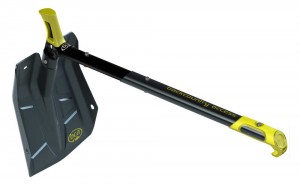The Dozer™ is only the third snow shovel that converts into a backcountry hoe for excavating large amounts of snow quickly, because it reduces shoveling from a three step process, to only two. So says Bruce Edgerly, BCA’s VP of Sales and Marketing. He’s right.
A normal shoveling operation requires driving the blade into the snow for the first step, then lifting it up for step two, and finally, taking a third step to toss it. When you’re using it like a hoe, you first swing the blade in to grab hold of the snow, then pull it sideways in a stroke that simultaneously tosses the snow backwards. It allows you to move more snow, faster — waaay faster. In effect, it allows you to become a human backhoe, efficiently scooping and throwing snow in a what can become a repetitive windmill like motion that moves snow with relentless, machine like efficiency.
So far, the only other light weight aluminum shovels that do this are K2’s Rescue Shovel Plus, and the Kodiak by Ortovox. The Dozer™ looks fairly beefy, thanks to an ovalized shaft and a solid T-style handle that doubles as the critical right angle to transform a straight shovel into an angled hoe blade. One side of the T-handle goes into the ferrel welded to the backbone ridge of the blade. The other acts as a horn to place one hand on for steadying the blade as you pull the snow. A small rubber sleeve at the opposite end of the shaft provides a small hook so that you won’t lose your grip at the far end of the shaft. The blade is not only heat treated, but also “coined” for greater strength and rigidity.
In truth I’m not looking forward to ‘testing’ this shovel. Shoveling is a load of work. But I’m confident once I put it through the paces on one of the more common test pieces available in Truckee — a berm of frozen slush blocking me in to my driveway, courtesy of the local plowman — the Dozer™ will make short work of that impasse thanks to its hoe function. That and my trusty HS928. 😉
Backcountry Access
The Dozer™
MSRP: $79.95
Weight: 33 oz. (936 g)
Blade Dimensions: 10″ x 11″ (25 x 28 cm)
Handle+Shaft Dimensions: 18½” (47 cm)
Assembled Length (Hoe mode): 24.6″ (62.6 cm)
Assembled Length (straight): 31.9″ (81.1 cm)
Related Posts:
Strategic Shoveling: Human Snow Conveyor
Ortovox Kodiak Review
© 2012


5 comments
Skip to comment form
This design would work well with the “strategic shoveling” method you wrote about a few years ago, coming in to the victim perpendicular from “below”
Author
Indeed, that’s why I’m psyched on any manufacturer making a hoe-style shovel.
How big is that blade? I love the hoe idea, but I’m finding a monster blade doesn’t fit well in my covert pack.
Author
Kodiak blade fits in the outer compartment of a Covert – shaft too. My recollection is the Dozer blade is similar in size but I didn’t get specific dimension. Am certain the shaft would have to be stuffed in main compartment of a Covert. Hoping BCA will chime in with specifics.
Edited to add: Dimensions obtained and added in (see above).
Knee pads are also a big help in fast digging. Folks have a tendency to stand and dig to avoid getting on their knees. I wear them all the time and it makes dropping to the ground and doing hasty pits easier.
My regular shovel works pretty good and has proven durability having passed the “shake” test. The shake test is what you do in the store when shopping for a shovel. You assemble the shovel, then grab it by the shaft and shake it. The shovel with the least play and wiggle is the one that should be at the top of your choices. Some avalanche shovels are so bad they could be hung as wind chimes. Bigger is better. I find shovels that barely cram into the newer specialized pack slots too small. For instance my older BD shovel will not fit in the Avalung, but their new smaller shovels do. I cram it in the main compartment. The handle fits in the outer pocket or on the shovel.
My current shovel is 10″ X 12.5″ and it also has nearly 2″ of depth at its deepest giving it good carrying capacity.
I have never used an “army shovel” design which is what BCA is repeating with modern metals and such. Certainly would help excavate the buried properly according to Craig’s excellent article on that topic.